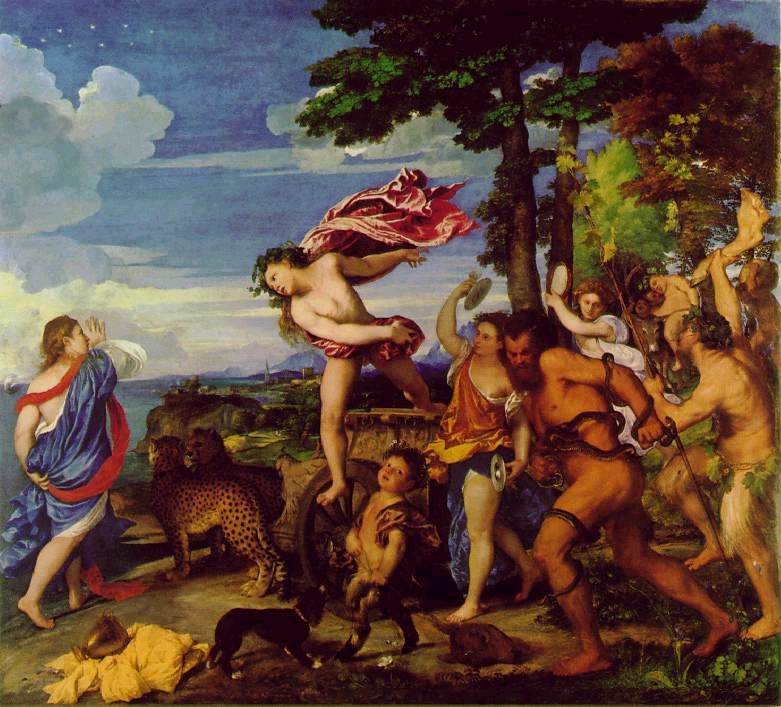- Bacchus and Ariadne
Infobox Painting|

title=Bacchus and Ariadne
artist=Titian
year=1520–1523
type=oil on canvas (applied onto conservation board 1968)
height=176.5
width=191
museum=National Gallery, London"Bacchus and Ariadne" (1520-23) is an
oil painting byTitian . It is one of a cycle of paintings on mythological subjects produced for Alfonso d'Este, the Duke ofFerrara , for the Camerino d'Alabastro – a private room in hispalazzo in Ferrara decorated with paintings based on classical texts. Originally an advance payment was given toRaphael , who originally held the commission for the subject of a "Triumph of Bacchus". At the time ofRaphael 's death in 1520, only a preliminary drawing was completed and the commission was then handed toTitian . In the case of "Bacchus and Ariadne", the subject matter was derived from the Roman poetsCatullus andOvid . The painting now hangs in the National Gallery inLondon . The other major paintings in the cycle are "The Feast of the Gods" (mostly byGiovanni Bellini , now in theNational Gallery of Art ,Washington, DC ), "The Andrians" and "The Worship of Venus" (both now in theMuseo del Prado ,Madrid ).Ariadne has been left on the island of Naxos, deserted by her loverTheseus , whose ship sails away to the far left. She is discovered on the shore by the god Bacchus, leading a procession of revellers in a chariot drawn by twocheetah s (These were probably modelled on those in the Duke's menagerie and wereleopard s in Catullus's original text). Bacchus is depicted in mid-air as he leaps out of the chariot to protect Ariadne from these beasts. In the sky above the figure of Ariadne is her crown, which Bacchus has thrown into the sky and it then becomes the constellation Corona.The composition is divided diagonally into two triangles, one of blue sky (using the expensive "
lapis lazuli " pigment) and still but for the two lovers caught in movement, the other a riot of movement and predominantly green/brown in colour. The follower of Bacchus who struggles with a snake was influenced by the antique sculpture of "Laocoön and his Sons " which had recently been discovered inRome . The King Charles spaniel that barks at the boysatyr is a common motif in Titian's work and was probably a court pet. The gold urn inscribed with the artist's signature (TICIANVS) may also have been familiar to the Duke as one of the antiquities in his collection.Restoration
The canvas on which "Bacchus and Ariadne" is painted was rolled up twice in the first century of its existence, which had disastrous consequences for the painting. From the turn of the 19th century onwards it was frequently being restored to stop paint from flaking off, the last and most controversial restoration being that carried out at the National Gallery between 1967 and 1968. When discoloured
varnish lying directly on top of the paint surface was removed, much of the paint itself came off as well and extensive repainting was necessary. This has caused some critics to note that the expanse of blue sky on the left-hand side, one of the worst-affected areas of the painting, appears flat and pallid. It has also been argued that the removal of the varnish has left the painting tonally out of balance, since Titian is likely to have added some subtle glazes to the paint surface in order to tone down some of the more jarring colours. The National Gallery maintains that this was an unavoidable loss, because the accrued layers of later varnish had turned the painting brown and sludgy and had to be removed.Popular culture
A modified version of the picture was used on the cover of the
Crash Test Dummies album "God Shuffled His Feet ". It also appeared in the 2006 film "V for Vendetta" as a banned work of art.References
*
*
Wikimedia Foundation. 2010.
